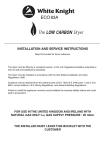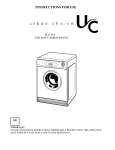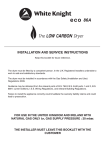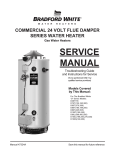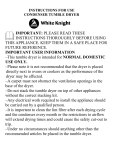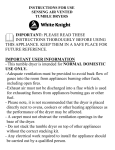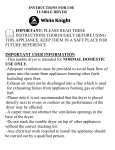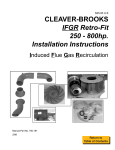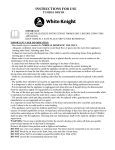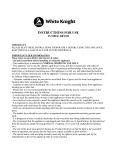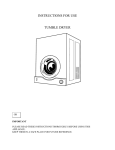Download Crosslee PLC eco 43a the low carbon Technical data
Transcript
INSTALLATION AND SERVICE INSTRUCTIONS Keep this booklet for future reference. The dryer must be fitted by a competent person. In the U.K. Registered Installers undertake to work to safe and satisfactory standards. The dryer must be installed in accordance with the Gas Safety (Installation and Use) Regulations 1998. Guidance may be obtained from the relevant parts of B.S. 7624: B.S. 5440 parts 1 and 2, B.S. 6891: current editions, I.E.E. Wiring Regulations, and relevant Building Regulations. Failure to install the appliance correctly could invalidate the warranty liability claims and could lead to prosecution. FOR USE IN THE UNITED KINGDOM AND IRELAND WITH NATURAL GAS ONLY : I2H, GAS SUPPLY PRESSURE : 20 mbar. THE INSTALLER MUST LEAVE THIS BOOKLET WITH THE CUSTOMER Contents Page Technical Data . . . . . . . . . . . . . . . . . . . . . . 3 Installation . . . . . . . . . . . . . . . . . . . . . . . . . . 4 Service instructions . . . . . . . . . . . . . . . . . . 6 Fault Finding . . . . . . . . . . . . . . . . . . . . . . . . 8 Wiring diagram . . . . . . . . . . . . . . . . . . . . . 12 Exploded views . . . . . . . . . . . . . . . . . . . . .13 Parts list . . . . . . . . . . . . . . . . . . . . . . . . . . . 18 WARNING THIS APPLIANCE SHALL BE INSTALLED IN ACCORDANCE WITH THE LOCAL REGULATIONS IN FORCE AND ONLY IN A WELL VENTILATED SPACE.READ THE INSTRUCTIONS BEFORE USING OR INSTALLING THIS APPLIANCE. THIS APPLIANCE CONFORMS TO THE FOLLOWING EEC DIRECTIVES. LOW VOLTAGE DIRECTIVE LVD 2006/95/EC:EN60 335-1, EN60 335-2.11. GAS APPLIANCE DIRECTIVE (GAS) 90/396/EEC:BS 5258:PART 17:1992. EN 1458-1, 2000 ELECTROMAGNETIC COMPATIBILITY DIRECTIVE 2004/108/ EC:EN55014, EN 61000 - 3 - 2, EN 61000 - 3 - 3, EN 50366 2 TECHNICAL DATA CONTROL GENERAL Type:Pactrol full sequence flame control, P16AGTD(CE) 414601. Ignition electrode gap to burner 3 to 4mm Flame failure electrode (4213 078 52641).Height from heater base to centre of electrode 27.0±0.5mm. Front loading tumble dryer with gas heating. Reverse action drum tumble.Time control. 2-temperature exhaust thermostat control.Induced air flow enters dryer through front grille, some passes through the gas burner into the rear ducting and some into the cooling passages, this mixed air enters the drum through the rear perforations, passes through the clothes, lint filter, and the fan and is discharged through the vent at the rear. CONNECTIONS Gas pressure:Rp 1/2 (1/2”B.S.P.parallel internal thread). Nominally 20mbar Electric: 230V.50 Hz, earthed supply, 13A fuse. (wall socket must have efficient earth connection and correct polarity) DIMENSIONS Height 85 cms.(33 1/2”) Width 59.6 cms.(23 5/8”) Depth 57 cms.(22 1/2”) Depth when rear vent hose assembled 60cms.(23 5/8”) WEIGHT With packing 37 kg Without packing 36 kg SUPPORT Machine rests on 2 rear positioned rollers and 2 non adjustable feet. AIR-FLOW Approximately 120 cubic metres per hour with capacity clothes load. IDENTITY Manufacture date, and serial number are displayed on a plate revealed when machine door is open. The first 4 numerals identify year and week of manufacture. The last 6 numerals identify the machine.ALL INFORMATION FROM THIS PLATE SHOULD BE QUOTED IN ANY SERVICE COMMUNICATION. COMPONENTS DRIVE MOTOR Permanent split capacitor (8µF)4 pole—Approx. 1/8 HP Overload protection approx.130°C BURNER Pressed steel with slotted flame perforations. Heat input:3.0kW (10235 Btu/hr).Injector 1.32 mm dia. 3 INLET THERMOSTAT (Brown wires identification) Bi-metal contacts normally closed. Contacts open if airflow restricted. Contacts open 130°C ±3°C Contacts reset 100°C ±5°C INLET TEMPERATURE LIMITER (White wires identification) Bi-metal contacts normally closed. Contacts open if INLETTHERMOSTATfails. Contacts open 143°C ±3°C Contacts reset 100°C ±5°C EXHAUST THERMOSTATS Bi-metal contacts normally closed. Normal Fabrics:Contacts open 60°C ±3°C 60°C (green spot Contacts reset 49°C ±4°C identification) Delicate Fabrics:Contacts open 50°C ±3°C 50°C (red spot Contacts reset 35°C ±3°C identification) DRUM Volume 105 litres Speed approx.50/59 r.p.m. Capacity 7 kg dry cotton Rotation clockwise 5 mins., anticlockwise 10 secs TRANSMISSION Poly-vee belt driven by vee-grooved motor pulley to outer circumference of drum. TIMER Electric 140 minutes combined forward and reverse 5 min cycle with 10 seconds reverse. HEATER SWITCH Single pole, ON/OFF, PUSH-PUSH R.F.I.FILTER 0.1µF +2x2400pF +2x5mH +2M2 ACCESSORIES VENT HOSE ASSEMBLY0312 001 01001 WALL/WINDOW VENT KIT0312 005 01001 STACKING KIT0312 003 01001 RESTRAINING KIT0312 006 01001 INSTALLATION 5 POSITION OF DRYER AND CONNECTIONS 1INSTALLATION The dryer is designed for installation using a flexible gas connection with tubing in accordance with B.S.669. Ensure that the supply gas sizing is adequate. When installing, position the appliance so that the plug is accessible. An electric supply cord with moulded-on 13 Amp.plug is fitted at the back of the dryer.The length is 1.5 m.(5ft.). If there are any other appliances that are relatively high rated (eg a central heating boiler)fed from the same gas supply branch.It is advisable to perform the verification of inlet pressure with both appliances in operation. Prior to installation, check that the local distribution conditions, nature of gas and pressure and adjustment of the dryer are compatible. 2 AIR SUPPLY The tumble dryer shall be installed in a room or internal space having an openable window, or equivalent.The customer must be advised that this must be kept open during use. Purpose provided ventilation of 100cm shall also be provided where the room volume is less than 3.7m³/kw of appliance rated heat input. Additional guidance on the provision of air supply may be obtained from BS5440 parts 1 and 2 and BS 7624:2004 If the dryer is to be installed in a room or internal space that already contains one or more fuel burning appliances, the ventilation requirements above, together with any additional requirements of BS5440-2:2000, 5,5 shall be applied. 3 POSITION The dryer must not be installed in a bedroom, bathroom or shower room. Great care is required in the location of the dryer in premises where concentrations of flammable vapours may accumulate, e.g.commercial garages and associated workshops. The dryer can be placed against a wall, other appliances, kitchen furniture and similar surfaces. The illustration shows the minimum space required by the dryer and the position of the gas wall connector.It is not acceptable to use a forward facing mounting plate because of the space limitation.The sideways facing assembly must be used and this should be fitted so that the flexible hose hangs down from the bayonet connector. A 13 Amp socket must be provided within a distance of 1.4 m (55 in.) of the cable entry into the dryer.The socket must have an efficient earth connection. If the dryer is to stand on a surface above the floor or on top of a washing machine (using the Stacking Kit) then the 750 mm dimension is measured above the supporting surface. If the dryer is installed under a worktop there must be a minimum gap of 15 mm between the top of the dryer and the underside of the worktop to allow for ventilation. 4 VENTING The dryer must be fitted with an exhaust vent hose and the end either hung out of a window or fitted to a wall/ window vent connection. Note: Do not obstruct or add a mesh to the vent hose outlet during use and ensure that it cannot be blocked or bent sharply which obstruct the air flow. It is recommended that the interior of the hose be periodically inspected and cleaned if necessary. If it is intended to move the dryer regularly for use then the Restraining Kit must be fitted to prevent possible damage to the gas connection. PERMANENT VENTING Accessory wall/window vent kit CL005 is available: See illustration for necessary hole through wall.Dim A= 200mm and Dim B= 100mm for direct alignment. Note DimBmay be increased to 200mm to facilitate easier drilling if required. Stacking Kit We also recommend the fitting of a restraining kit to any dryer which is stacked. If using accessories: Wall/Window Vent Kit Restraining Kit See separate fitting instructions included with each Kit. 4 6. OPERATIONAL CHECK 6.1 Remove the pressure test point screw from the gas tee connection at the back of the dryer and connect a gas pressure gauge. 6.2 Check that the dryer timer is in the 'off' position, and that the heat switch is set to 'high'. Remove anything from inside the drum, check that the lint filter is fitted, shut the dryer door. 6.3 Turn on the gas, push the electric plug into the socket and switch on the electricity supply. 6.4 Turn the timer clockwise to a setting of at least 30 mins.Check for ignition.If the gas fails to remain lit then repeatedly turn the timer on and off (or open and close the door and push the start switch) for periods of at least 30 seconds until the air is removed from the system and burning is continuous. Note that gas is not lit when the drum is turning anticlockwise. 6.5 With the gas burning ensure that the pressure is as detailed in the Technical Data.Turn off and replace the pressure test point screw.Check for soundness. 6.6 Switch on again and re-start so that the gas is burning.Disconnect the flexible gas hose and check that the solenoids can be heard to close.After 30 seconds turn on the gas and check that there is no re-ignition.Switch the machine off and on again and check for re-ignition. 6.7 Check that the operation of the machine does not cause spillage of products of combustion from any open flued gas appliance in the same room, or from appliances in adjoining rooms, e.g.a gas fire or central heating boiler. 6.8 In the event of an electrical fault after installation of the appliance, preliminary electrical system checks must be carried out (i.e.earth continuity, polarity and resistance to earth). 6.9 IMPORTANT INFORMATION RE-FUNCTIONING OF THE FULL SEQUENCE FLAME CONTROL BOX. THE FULL SEQUENCE FLAME CONTROL BOX ON THIS APPLIANCE REQUIRES A 6 SECOND RE-SET PERIOD FOLLOWING EACH INTERRUPTION OF INPUT VOLTAGE. 6 SECONDS DELAY IS REQUIRED BETWEEN EACH ATTEMPT TO RESTART THE APPLIANCE FOLLOWING SWITCHING IT OFF, OR AFTER OPENING THE DOOR. 7 AIRFLOW It is most important that airflow to the plinth is not restricted. 8 MAINTENANCE This appliance does not require an annual service unless it is required as part of a landlord's gas safety certificate. If you do have any maintenance activity carried out, it should be carried out by a competent person (i.e. registered Engineer). 9 STACKING Instructions for stacking, if required, are supplied with the stacking kit. PROGRAMME Clockwise rotation of the control knob closes switch contacts within the timer to:a) energise the drive motor, and b) energise the full sequence flame controller. The timer switch controlling the drive motor and the timer motor, remains closed until the timer motor mechanism returns the control knob to the '0' position.The timer switch controlling the full sequence flame controller opens 12 minutes earlier to provide a cool-down period. The full sequence flame controller opens the tandem solenoid gas valves after a delay time of about 8 seconds and operates the pulsing spark ignition.If the flame is not detected by the flame failure electrode within 10 seconds then the valves are closed.The system must then be reset by switching the machine off and re-starting. The heat selector switch provides options for either 60°C, or 50°C, exhaust thermostat control.This results in the burner cycling on and off giving Ionger than anticipated drying times.Drying times vary depending on the weight and size of the articles, type of fabric, dampness etc. These thermostats turn off the heating towards the end of the chosen cycle and so avoid waste of energy.The lower temperature thermostat prevents delicate fabrics from getting too hot with possible risk of damage. An inlet thermostat is fitted in the ducting at the back of the dryer.It may also operate under certain other conditions of restriction of the air-flow, for example, an overloaded drum or blocked lint filter.This thermostat switches off the flame controller.This will result in the burner cycling on and off giving longer than anticipated drying times. Should the thermostat fail there is an inlet cut-out connected in circuit with the gas valves.After operation, the cut-out must be re-set by switching OFF/ON the mains supply, to restore heating but a service call may be required to correct the initial fault. The conditions of failure of the air flow, blow-back, or of gas interruption are detected by the flame failure electrode and the system is shut-down. Both drum rotation and heater control are switched off when the door is opened and switched on when the door is reclosed, and the start button pressed. For programme times see chart on dryer control panel. Note:Do not allow fluff to accumulate around the dryer. 5 SERVICE INSTRUCTIONS RECOMMENDATIONS FOR DISMANTLING Note:Re-assembly should be done in reverse sequence to these instructions. Terminal Block (28),Control Unit (10),Timer (211), Heat Switch (235),Neon (213),Micro-Switch Assembly (248),Control Panel (353). Withdraw 3 screws from the back flange of the Table Top Assy.(386) and lift and move it rearwards for removal. This gives access to the 2-screws securing the Control Unit Bracket (11) to the top flange of the Cabinet. Pull off the Timer Knob (352) by means of a loop of thin insulating wire inserted behind it, to expose the 2-screws securing the Timer (211) to the Control Panel (353). To remove the Neon (213) disconnect the faston connectors and push the neon out of the control panel. To remove the Control Panel (353), disconnect the faston connectors from the Timer, Neon, and Heat Switch. Withdraw 3-screws securing the Control Panel lugs to the Cabinet top rail.Tilt the Control Panel so that the bottom lugs can be freed from the top flange of the Front Panel (376). To remove the door Micro-Switch Assy.(248), withdraw the 3-screws securing the Control Panel lugs to the cabinet top rail and free the Control Panel Assy from the top flange of the Front Panel.Open the door and withdraw 2 screws securing the Micro-switch Assy, to the Front Panel, unclip the wires from the top flange of the Front Panel, lift out the Assy, and disconnect the faston connectors. A capacitor (112) is mounted to the motor assembly Disconnect the wires to the capacitor before removing the capacitor or the motor capacitor assembly. The fan (446) is secured to the Motor Shaft by the Spring Clip (448) and the finger on the Fan Boss must be lifted before the fan can be withdrawn from the Motor Shaft. It is important that rigid support is provided to the motor shaft when the fan is being refitted.This is to avoid disturbance of the motor bearings from their location. On reassembly of the fan access cover (447) it is important to hold the protruding finger grip at a “2 o-clock” position to find location.Push the cover fully on to the fan chamber prior to rotating it clockwise and engaging tightly in al 3 locations.Re-insert the black headed pin (537). TO RELAX MOTOR CLIPS REAR ACCESS LOWER Exhaust Thermostats (229,250),Motor Assembly (101),Fan Assembly (446),Capacitor (112). Withdraw the 6 screws securing the Cover Plate (19) to the Back Panel (24) and remove it.Pull out the Exhaust Tube (30). This gives access to the Exhaust Thermostats (229, 250), which are each secured to the Banjo (440) by a screw. Note:The 50°C thermostat is identified by a red spot on the body. REAR ACCESS LOWER (continued) To remove the Motor (101) the belt (125), must first be removed from the Motor.Disconnect the Motor leads. Withdraw the black headed pin (537).Exert an anticlockwise force to disconnect the bayonet fitting between the Fan Access Cover (447) and the back of the Banjo Assy (440).From underneath the dryer withdraw the 4screws (396) securing the Motor Bracket (432) to the cabinet base.Lift out the Motor and Fan Assy. Special tool (7813 002 61111) is recommended when installing a new belt which needs to be levered and stretched onto the motor spindle (see illustration). HEATER ASSEMBLY REMOVAL Heater Assy.(32),Solenoid Coil (45 or 45A),Flame failure Electrode (33),Ignition Electrode (39). Withdraw the 2-screws securing the Plinth (199) to the Cabinet, unhook the bottom edge fixing, and remove it. Separate the 4-way Housing (31) to release the wiring from the Heater Assy.to the Cabinet. Lay the dryer flat on its front, supported to take the weight from the door and controls. Withdraw the 6-screws securing the Cover Piate (19) to the Back Panel (24) and remove it.Pull out the Exhaust Tube (30). Withdraw the 4-screws securing the Hot Air Elbow Assy. (20) to the Back Panel (24) and remove it. Disconnect the External Feed Pipe (15) from the Tee Piece (27). Pull the connectors off the Flame failure Electrode (33) and the ignition Electrode (39). 6 Withdraw the 3-screws and shakeproof washers (13) securing the Flame Tube Assy.(34) to the Cabinet Base. Note:On re-assembly the shakeproof washers must be replaced to ensure a good earth connection. Lift out the Heater Assy. To remove either solenoid coil (45 or 45A) disconnect the electrical connectors, unscrew the nut (44). To remove the sensing electrode (33), withdraw the screw (41) lockwasher (482) and nut (411) securing it to the Flame Tube Assy.(34).Note on re-assembly the lockwasher (482) must be replaced to ensure a good earth connection. To remove the Ignition Electrode (39), withdraw the screw securing it to the top of the Heater Tube Assy.(34). If there is a fault in the valves, burner or other parts of the gas line, then the Heater Assy.(32) must be replaced. INLET THERMOSTAT & THERMAL OVERLOAD CUTOUT (TOC) REMOVAL Lay the dryer flat on its front, supported to take the weight from the door and controls. Withdraw the 6-screws securing the Cover Plate (19) to the Back Panel (24) and remove it.Pull out the Exhaust Tube (30).Disconnect the Fasten connectors from the 4way Terminal Block (142) as necessary (see wiring Diagram for colour code).Cut off the 2-Cable Ties (387). Note:on reassembly these must be replaced by new components to secure thermostat wiring away from contact with the drum. Withdraw the 16-screws securing the Rear Banjo (18) and lift it off. Withdraw the screws securing the Thermostat (230) and/or TOC (38) and pull the connecting wires through the Grommet (25). Note:Operation of the TOC should only occur if the thermostat has failed.If the TOC should also fail this results in high temperatures in the dryer. REAR ACCESS UPPER Rear Seal Assy.(14),Drive Belt (125),Drum (266), Drum Shaft and Bearing (270). Remove the table top assembly (386) and disconnect the Faston terminals from the 2-way Terminal Block (28). Lay the dryer flat on its front supported to take the weight from the door and controls. Withdraw the 6-screws securing the Cover plate (19) and remove it.Pull out the Exhaust Tube (30). Withdraw the 4-screws securing the Hot Air Elbow (20) and remove it. Disconnect the External Feed Pipe (15) from the T-piece (27). Withdraw the 16-screws securing the Rear Banjo (18) and lift it off. Disconnect the Faston connectors from the Inlet Thermostat (230) and the TOC (38) from the 4-way Terminal Block (142). Withdraw the 3-screws (412) securing the Drum Shaft and Bearing Assy.(270) to the Back Panel (24). Withdraw the 8-screws securing the Back Panel (24) to the Cabinet (196).Disengage the T-piece Grommet from the slot in the Back Panel and lift off. The Rear Seal (14) can be prised off the inside of the Back Panel (24) with a screw-driver, but care should be taken not to damage the inner sheet metal flange. Remove excess adhesive before fitting the replacement Rear Sear (14) using the impact adhesive (Scotchgrip 1099). To remove the Drive Belt (125) it should be disconnected from the Motor Pulley and lifted off the Drum. Note:When re-placed the drive belt should be located within the lines marked on the Drum circumference. After removing the Drive Belt the Drum Assy.(266) can be lifted out. For dismantling the Drum Rear Bearing (270) access to the Earth Finger (421) securing screw (420) is through a hole in the back of the Drum.After removal of the Earth Finger the screw (422) securing the Drum Shaft Assy. (426) is through a hole in the centre of the back of the Drum. Note:It is important that the recess in the head of the shaft centre screw (422) is filled with electrically conductive grease, e.g.Electrolube 2G. When dismantling the Drum Rear Bearing care should be taken not to allow parts to fall into the space between the back of the drum and the drum rear seal plate. FRONT ACCESS Front Panel (376),Banjo Assembly (440),Front Seal (442),Front Bearings (441 and 445). If the Banjo (440) is to be removed then the exhaust thermostats should first be disconnected or removed as described in REAR ACCESS LOWER. Remove the Top Cover (386), the 3-screws securing the Control Panel lugs to the Cabinet top rail, and the screws securing the Micro-Switch Assy.- See TOP ACCESS. Lay the dryer on its back. Withdraw the 2-screws securing the plinth (199) to the Cabinet, unhook the plinth fixings and remove it. Withdraw the 2-screws (357) securing the Latch Guide (370) to the Front Panel (376) and remove it. Withdraw the 2-screws securing the Hinge Assembly (359) to the Front Panel.Remove the Door and Hinge Assy. Withdraw 3-screws securing the Front panel to the Banjo Assy.(440) - 2 in the Front Panel bottom flange and 1 countersunk screw adjacent to the door opening. Withdraw the 4-screws securing the Front Panel to the Cabinet.Lift off the Front Panel. Disengage the Banjo (440) from the front of the Drum and disengage the location lug with the Cabinet base. Remove the Banjo Assy. The Front Bearings Short (441) and long (445) can be unclipped from the Banjo flange to release the Front Seal (442).Care is needed to avoid breaking these bearings. 7 FAULT FINDING In the event of an electrical fault carry out the preliminary electrical system checks i.e. earth continuity, polarity, and resistance to earth. Use each chart to locate the fault causing the dryer to operate incorrectly as follows: Chart No: 1 Motor does not run. 2 Motor runs but full sequence control does not produce ignition spartk. 3 Motor runs, Full Sequence Control produes ignition sparks, but gas does not ignite. 4 Motor runs, gas ignites but burns for only a short period. Chart 1. Motor does not run Start Yes Exchange R.F.I. filter, does motor start? No Yes Correct as necessary does motor start? Yes Check fuse and mains cable for continuity, does motor start? Yes Yes Yes Is there electrical continuity across both live and neutral paths of R.F.I. filter? No No Check door closed, timer ON electrical supply ON. Depress start switch. No No Check br/w wiring from RFI filter to door switch. Check connections clean and tight, does motor start? No Is voltage between input to door switch and Neutral 230V? No Exchange door switch does motor start? No With door closed is output from door switch 230V? No Exchange timer. Does motor start? Is voltage at terminal d1 on timer 230v when the timer is turned on? No Exchange timer. Does motor start? No No Yes Exchange door relay PCB. Does motor start? Yes Is voltage between L and N on main terminal block 230V? No Yes Yes Is voltage at terminal T3 on door relay PCB 230v when timer is turned on? Yes Yes Yes Yes No Is voltage between live and terminal T2 on door relay PCB 230v when timer is turned on and start switch depressed? No No Yes Yes Substitute capacitor. Does motor run? No Refit capacitor, change motor. Refer to chart 2 With motor running does gas attempt to light? Refer to chart 3 Does gas light? Yes Yes Yes Refer to chart 4 8 Does gas stay on? Machine operating. Instruct users as necessary? Yes Chart 2. Motor runs but full sequence control does not produce ignition spark With timer ON (30 min) is voltage between output C2 on timer and TB-N 230v?? START No Yes Exchange timer. Does control spark? Yes Does control spark with low heat selected? No No Yes Check continuity of red wire between timer C2 and heat selector switch. Are connections clean and tight. Does control spark? Yes Exchange heat selector switch. Does control spark? Exchange both exhaust thermostats (150 °C and 60°C) and inlet thermostat 130 °C (brown wires).Does control spark? Yes Disconnect the red wire from the exhaust thermostat. CAUTION ! IT IS LIVE! Is voltage between heat selector switch and TB-N 230v? No No No Yes Does control spark with high heat selected? Yes No Change 50 °C exhaust thermostat. Does control spark? Yes No With red wire still disconnected is voltage between output of heat selector switch and TB-N 230V at high heat setting and zero volts at low setting. Yes Yes Reconnect the red wire to the exhaust thermostat. Is voltage between brown wire in control box multiway connector and TB-N 230V? No No Exchange full sequence control unit. Does control spark? Yes No Check HT lead is connected to control and electrode. Does control spark? Yes Ja Check condition of ignition electrode and spark gap is correct by removing heater assembly. Does control spark? Exchange full sequence control unit. Does control spark? Yes Yes 9 Refer to chart 3 No Refer to chart 4 No No Yes Does gas light? Yes Does gas stay on? Machine operating. Instruct users as necessary. Yes No Chart 3. Motor runs Full Sequence Control produces ignition sparks, but gas does not ignite. Start Remove plinth 199. Can gas be lit manually? No Yes Check spark gap continuity of H.T. lead and electrode not cracked. Does burner light? Yes No Whilst control is sparking is voltage at terminal 4 of control unit 230V? No Yes Yes Exchange control unit. Does gas light? Yes Check gas control relay wiring. Exchange if wired correctly. Does gas light? No Whilst control is sparking is voltage at gas control relay PCB terminal T1 230v? No Yes No Using the looping connections on the terminal block on the base at the rear, check that the voltage to the solenoids is 230v whilst the control is sparking No Yes Yes Is voltage between input and neutral on each solenoid 230v? Check wiring between control unit and 4 Way Terminal block. If necessary exchange 143°C inlet temperature limiter. Does gas light? No Yes No Yes Yes Check continuity of wiring between 4 Way housing and relevant solenoid also neutral wiring. Check plug clean and tight. Does gas light? Exchange Heater Assembly. Does gas light? No Exchange solenoid coils in turn. Does gas light? Yes No No Fault in gas system rectify as necessary. No Does gas stay on? Yes Refer to Chart 4 Machine operating. Instruct user as necessary. 10 Chart 4. Motor runs, gas ignites but stays on for only short period Before proceeding, ensure polarity of 13Amp supply socket and earthing is correct Is weight of load suitable? Is filter clean? Is vent hose or terminal unobstructed? Is vent terminal unaffected by wind conditions that may cause back pressure? Start No Yes Yes Check gas pressure with all other appliances in operation does gas stay ON? Yes No No Is flame failure electrode correctly positioned, and undamaged? Is wire to terminal 9 undamaged and connections tight? Is rear drum seal complete? Is rear elbow and plinth attached correctly? Rectify as necessary does gas stay ON? No Exchange full sequence control and/or gas control relay PCB and/or thermostats as necessary until gas stays on. Yes Yes Machine operating. Instruct user as necessary. 11 WHITE KNIGHT ECO 43A_ CROSSLEE P.L.C. 12 WHITE KNIGHT ECO 43A_ CROSSLEE p.l.c. EXPLODED VIEW 1 213 391 235 497 372 211 386 10 11 196 369 248 249a 249b 353 352 201 362 203 359 363 203a 367 366 365 364 357 370 376 199 354 394 403 13 WHITE KNIGHT ECO 43A CROSSLEE P.L.C. EXPLODED VIEW 2 REAR ASSEMBLY VIEWED FROM FRONT 230 144 38 408 409 410 411 141 28 398 15 16 17 389 375 375 393 143 13 18 375 20 14 23 21 22 412 375 19 24 25 26 27 25 403 396 14 WHITE KNIGHT ECO 43A_ CROSSLEE P.L.C. EXPLODED VIEW 3 INTERNALS VIEWED FROM REAR 455 454 248 440 441 442 445 446 447 456 457 458 459 445 448 356 250 229 29 30 32 31 406 13 15 WHITE KNIGHT ECO 43A_ CROSSLEE P.L.C. EXPLODED VIEW 4 INTERNALS VIEWED FROM REAR 270 266 444 427 101a 101 112 125 432 142 16 White Knight ECO43A_ Crosslee plc Exploded View 5 45 31 375 39 41 33 482 411 13 32 17 BG43A_ PARTS LIST Item 10 11 13 14 15 16 17 18 19 20 21 22 23 24 25 26 27 28 29 30 31 32 33 38 39 41 45 101 101a 112 125 141 142 143 144 196 199 201 203 203a 211 213 229 230 235 248 249a 249b 250 266 270 352 353 354 Description Control Unit Control Unit Bracket Assembly Screw M4 x 10 Rear Seal Assembly External Feed Pipe (Bundy Tube Assy 3) Gas Inlet Connector Restrainer Plate Rear Banjo Cover Plate (access) Hot Air Elbow Assembly Air Channel/lnsulating Plate Assembly Air Guide Cable Clip Back Panel Assembly Grommet Captive Nut No 8 ’U’ Type Tee Piece/Test Nipple/Plug Assembly Terminal Block - 2 Way Exhaust Elbow Assembly Exhaust Tube 4 Way Housing Assembly Gas Burner Assembly Flame Failure Electrode Inlet Temperature Limiter 143 Deg C Ignition Electrode M4 x 10 Pan Screw Solenoid Coil (SCEM) Motor and Capacitor Assembly Motor (Ceset/Olmo) Capacitor 8µf Drive Belt Mains Cable Terminal Block Interference Filter Earth Tab Cabinet Assembly (Mid White) Plinth Assembly (Mid White) Door Seal Complete Door Frame Assembly (Mid White) Door Frame Assembly (Mid White) Timer T600 Neon Assembly Exhaust Thermostat 60 Deg C Inlet Thermostat 130 Deg C Electronic Start Assembly Micro Switch Assembly Gas Control Relay assembly Gas Control Relay assembly Exhaust Thermostat 50 Deg C Drum Assembly Drum Shaft/Bearing Kit Timer Knob Assembly (Mid White) Control Panel Assembly Locator Peg Part Number Expl. View 4213 092 25451 1 4213 070 08623 1 8213 130 37161 2,3&5 4213 092 08511 2 4213 089 0788_ 2 4213 078 49504 2 4213 070 08741 2 4213 080 08361 2 4213 070 08603 2 4213 089 0791_ 2 4213 089 07901 2 4213 070 08551 2 4213 078 26231 2 4213 089 07892 2 4213 077 08092 2 8213 130 37711 2 4213 092 08461 2 4213 078 44621 2 4213 092 08521 3 4213 077 48013 3 4213 092 08431 3&5 4213 092 08441 3&5 4213 092 19801 5 4213 092 24151 2 4213 092 08491 5 2522 180 40002 5 4213 092 08501 5 4213 092 25611 4 see 101 4 4213 092 08091 4 4213 092 18601 4 4213 076 35123 2 4213 078 44613 4 4213 078 52551 2 4213 092 41181 2 4213 092 45591 1 4213 092 45691 1 4213 077 08344 1 4213 092 45611 1 4213 092 45621 1 4213 078 57541 1 4213 078 50401 1 4213 078 53001 3 4213 092 24161 2 4213 092 46461 1 4213 092 05251 1&3 4213 092 51871 1 4213 092 51871 1 4213 078 49453 3 4213 092 08451 4 4213 092 05591 4 4213 092 45741 1 4213 092 51891 1 4213 077 61281 1 BG43A_ PARTS LIST 356 357 359 362 363 364 365 366 367 369 370 372 374 375 376 386 387 389 391 393 394 396 398 403 408 409 409 410 411 412 427 432 434 435 436 440 441 442 443 444 445 446 447 447/1 448 451 454 455 456 458 459 482 497 537 555 6G*3/8 DP/PWABE/NIBS/TSZPC 8Gx1 P/F AB S/TS MECH ZPC Hinge Assembly Window Door Frame (Mid White) Latch Pivot Latch Spring Door Latch Switch Strike Loom Clip Latch Guide Timer Bracket Pan Screw St M3 x 5 6 x 3/8 Earth Screw MZP Front Panel Assembly (Mid White) Table Top Assembly - Ellipse (Mid White) Cable Tie Screw 6AB x 6.5 Ellipse Left & Right Hand Button Assembly (Mid White) Flex Support Clip Foot Flb Ear Scr St Zn 8 x 3/8 Screw M4 x 25 Roller Assembly Cable Clamp 2 Washer M5 Form A M5 Form A Washer Screw 6 x 1/2 M4 Hex Nut Screw No 10-24 UNC x 3/8” Motor Retaining Clips Motor Mounting Bracket Loom Strap M8 Shakeproof Washer M8 Hex Nut Banjo Assembly Front Bearing (short) Front Seal 8 x 5/8 Recessed Pan Head Screw Lifter Front Bearing (long) Fan Access Cover (fan) Access Cover Assembly Fan Spring Clip Fln Tap Scr St Zn 8 x 1/2 Filter Screw 6 x 12 Banjo Seal Banjo Insert No 2 Banjo Insert No 1 M4 Toothed Lockwasher Switch Cover W’ Button (access cover) Rear Panels Seal Kit 8213 130 38051 8213 130 38101 4213 092 26071 4213 077 4409_ 4213 077 92271 4213 075 13013 4213 075 70833 4213 077 53413 4213 077 83571 4213 075 70941 4213 077 40992 4213 070 10933 2522 180 40001 8213 130 38051 4213 092 45681 4213 092 46211 4213 077 41772 2522 165 20003 4213 092 45781 4213 077 40982 4213 077 39833 2513 202 01006 2522 180 40003 4213 092 35651 4213 077 47303 2522 604 60002 2522 604 60002 2522 165 20004 2522 402 50001 8213 130 31051 4213 078 4536_ 4213 080 0675A 4213 078 46311 8213 130 28961 8213 130 38091 4213 089 11992 4213 077 40952 4213 077 4094_ 8213 130 38021 4213 077 41009 4213 077 40962 4213 092 56771 n/a 4213 092 18081 4213 075 71162 2513 153 01003 4213 092 17821 2522 166 30001 4213 077 07992 4213 077 53502 4213 077 53492 2522 616 15007 4213 177 01141 4213 078 26311 4213 092 28001 3 1 1 1 1 1 1 1 1 1 1 1 1 2&5 1 1 1 2 1 2 1 1, 2 & 3 2&4 1&2 2 2 3 2 2&5 2 4 4 3 3 3 3 3 3 4 4 3 3 3 4 3 1 3 3 3 3 3 5 1 4 2 BG43A_ PARTS LIST Bearing Pads & Brush Seal Kit 4213 092 21171 Manufactured by: Crosslee plc. Lightcliffe Factory, Hipperholme, Halifax, West Yorkshire, HX3 8DE ECO 43A_ Installation/Service Book 4213 094 79351




















